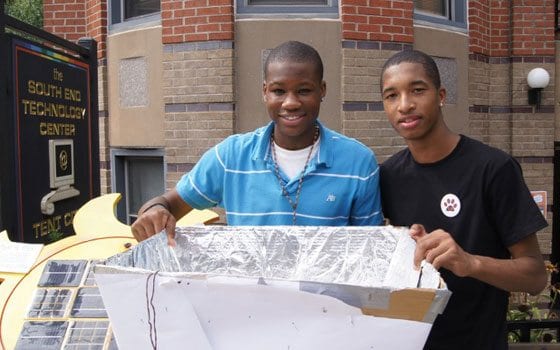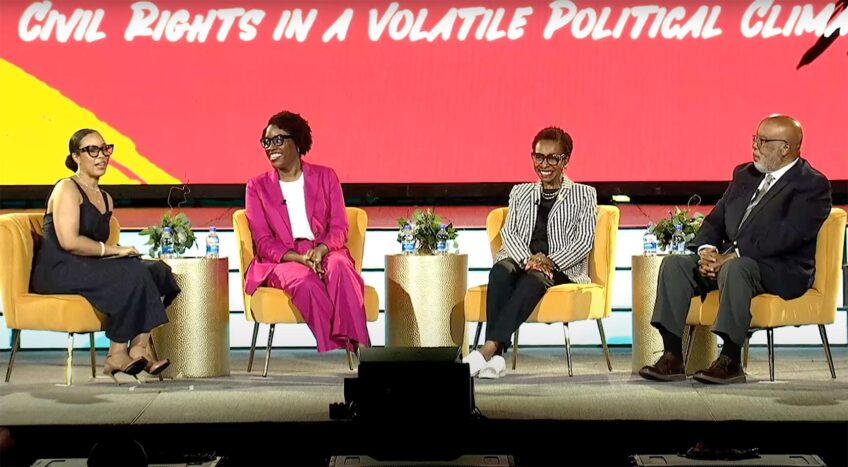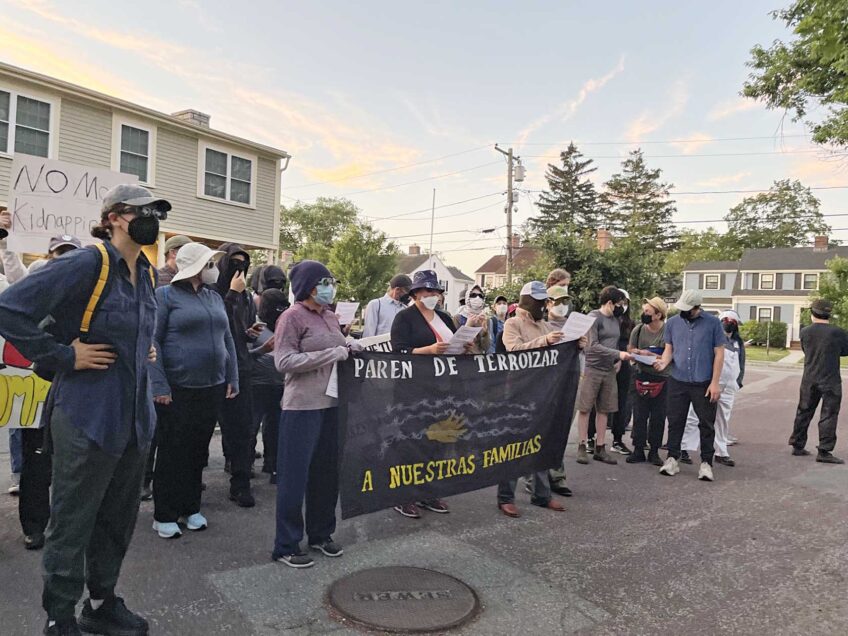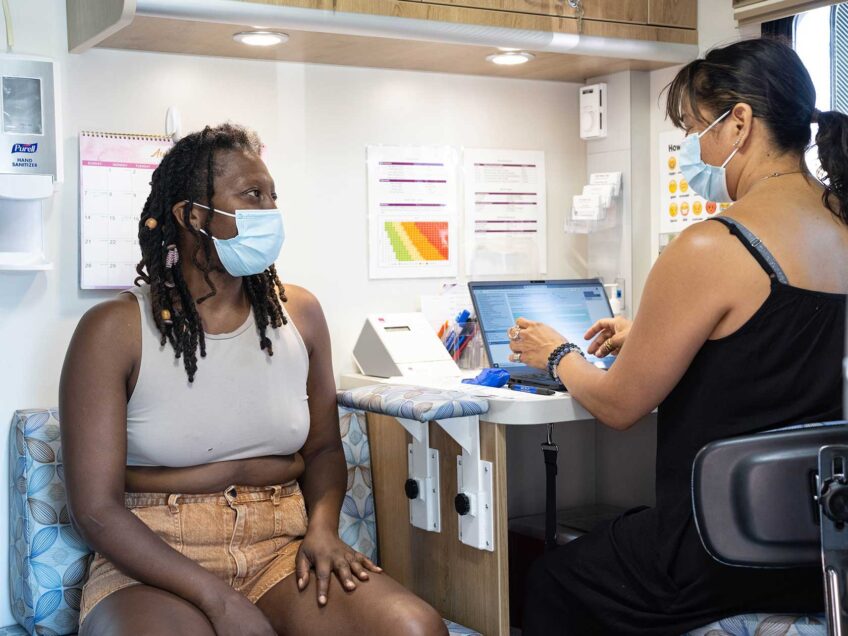

Author: Shelly RunyonJoe Otuechere, 15, of Braintree High School and Jalen Wiggens, 16, of TechBoston Academy hold up their solar-powered oven. They were two of 42 youth-teachers who taught 500 students this year in the Learn2Teach, Teach2Learn program.

In the basement of an unassuming brownstone on Columbus Avenue in the South End, there is a laboratory where dreams can become a reality.
It’s called the “Fab Lab.” It looks like a combination of a high-school computer and woodshop lab, with equipment to draft an idea and materialize in the next room.
The “Mill the Wind” group used the Fab Lab to cut windmill blades for a wind turbine that can be used to charge cell phones.
“Team Visionary” used the lab to construct “Billie the Kid,” the talking trashcan. A small, programmable computer screen sits a few inches from the top of the can and shows a googly-eyed face that encourages kids to throw away their trash.
“Billie” was programmed to interact with buttons on a display and would say with a smile, “Hi! I’m Billie. I’m a trashcan.” Or with a frown and a cough, “Trash on the streets makes the air dirty.”
Beckett Dunning, 18, will attend UMass Amherst this fall and spent this summer building out “Billie” with his teammates, and programming its interactive face as part of his participation in Learn2Teach, Teach2Learn (L2T,T2L).
He not only built this program, but used the experience to teach younger students about the technology.
“I found that Billie was a good way of showing the teaching,” said Dunning. “The best thing is not only knowing that you know something yourself, but the best display of knowledge is being able to teach someone else. So it’s really cool to be able to go out there and show people the things you’ve done and get them to understand it and maybe use it too.”
Each spring and summer high-school-aged teens from Boston, like Dunning, come to the Fab Lab inside the South End Technology Center @ Tent City to get paid to learn how to teach.
They apply for L2T,T2L, a five-month job which garners them $8 per hour. In the spring the teens attend Saturday sessions at Tent City and M.I.T. where they explore various programming technologies and discuss alternative energy sources.
In the summer they use their knowledge of technologies to prototype a device, present it and then build it at the Fab Lab. As the groups bring their ideas to life, they simultaneously teach junior high and elementary school-aged children how to use the same technologies.
At the end of the summer, the youth-teachers show off their devices at an expo. Dunning and his teammates, Xia Josiah-Faeduwor, Ariana Gibbons, John D O’Brien and Joshua Donald presented “Billie” this past Saturday.
The program participants are chosen from a competitive applicant pool that is found by word-of-mouth. Individuals are selected based on their answers on their application and during their interview. Other criteria include their eligibility for summer work-programs and their level of exposure to experiential learning techniques.
The less likely a child is to attain a better education, the more likely they are to be chosen for L2T,T2L.
“We get young people from every part of the city,” said Susan Klimczak, who assists the L2T,T2L program and the South End Technology Center @ Tent City. “And we do everything by word-of-mouth because we don’t think that the young people who we want to come into our program read posters.”
Klimczak said that most of the participants in L2T,T2L aren’t taught to look for opportunities outside of their environment, so they ask each participant from the previous year to ask people they know who they think will be interested in the technology.
The technology at the Fab Lab is so cutting edge that some of it isn’t even in stores yet. The hope is that the youth-teachers will absorb what they have learned and not only be able to teach it over the summer, but share what they learned with their peers who weren’t able to participate in the program. The reality is that many of these teens are affected in ways that they may not have imagined.
Jalen Wiggins of TechBoston Academy who turns 17 next month, had a lump in his throat when talked about his experience. “I miss the kids we left and they were really sad to see us go,” said Wiggins.
He said the experience was so positive for him because he was “doing the one thing I want to do — teach.”
Wiggins called this program his “first step to becoming a teacher.” As part of L2T,T2L Wiggins and his partner, Joe Otuechere, 15, of Braintree High School, presented their project at last Saturday’s exposition — a solar oven that cooked s’mores. A simple device, it was made of just tinfoil and cardboard — but it worked.
“The last day we brought it to a lot of the centers and we had a s’more party,” said Donna Park, who assisted the Roslindale Hub for L2T,T2L. “They kind of had the kids pretending it was a fire and they were sitting around it.”
Saturday afternoon was a bit overcast, so the oven wasn’t able to fully function, leaving the marshmallows warm with bits of brown around the top layer — but it was hot enough for the chocolate to melt and the overall sense of s’more was achieved.
In theory this may not have been the best day for presenting alternative technologies, but Klimczak would argue otherwise.
She explained that the purpose of the program is not to complete these projects, or have them work perfectly all of the time. In fact, she explained, they rarely do.
“We think young people should be exposed to emerging technologies now,” she said.
Klimczak further said that they know they are achieving success when a youth-teacher goes home or stands up in their high-school classrooms and talks about alternative energy or the programming languages they learned through L2T,T2L.
“That is how the change is catalyzed,” Klimczak explained, “They go home and they say, ‘I can do that, I can make that.’ ”






